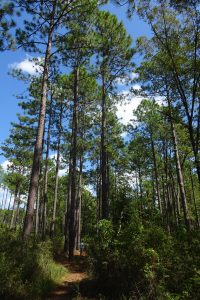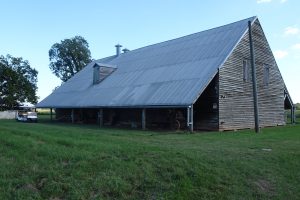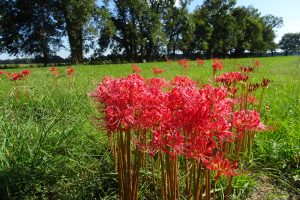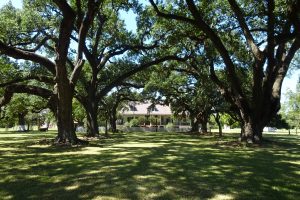30 Sep-2 Oct: A short but pleasant hike took us around the self-guided Longleaf Vista nature trail in a section of the Kisatchie National Forest in northwestern Louisiana. Several of the trees and shrubs were identified by signs along the way. The woods were dominated by the distinctive longleaf pine trees, with their very long needles. The visible growth of a young longleaf tree is slow at first, because at that stage it puts most of its energy into building a strong root system. Above ground it looks like a single large tuft of green needles nearly a foot high (foresters call this the “grass” stage). In subsequent years it then grows tall rapidly, and along with the shortleaf pine and the loblolly pine it is one of the most important southern yellow pines for the timber industry. The nature trail descended to a small creek, then climbed over two bluffs with good outlooks.


On our way to our campground, highway signs invited us to stop at an attraction not originally on our itinerary: Magnolia Plantation, part of the Cane River Creole National Historic Park. Although it was nearly closing time, the ranger offered to give us a guided tour as she made her rounds locking up buildings on the site. For about an hour, she told us a lot about the plantation and its people. Plantations in this region originally grew tobacco and indigo as cash crops, until the invention of the modern mechanical cotton gin by Eli Whitney in 1793 made cotton agriculture viable on a large scale. The cotton gin barn at Magnolia was not destroyed by the Union during the Civil War, so the machinery on display is a good example of cotton processing technology of that era. As we wound through Magnolia’s grounds, we noticed bunches of distinctive red flowers: spider lilies, a fall-blooming flower traditionally planted in this region. The next day we went to two more Cane River plantations open to the public, Oakland Plantation (part of the same NHP) and Melrose Plantation (a private museum). Each illustrated different aspects of plantation life in this Creole region, which passed back and forth between Spanish and French control at various times before it was acquired by the U.S.


